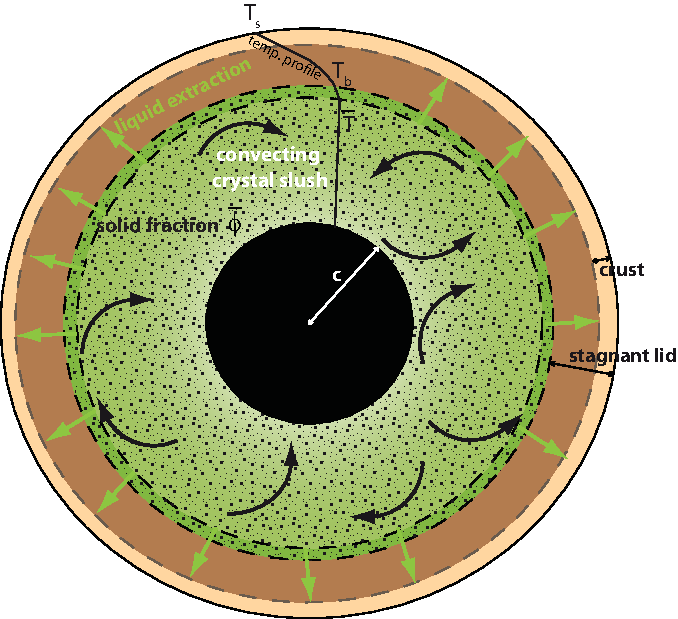Publication of the LGL-TPE in the journal Geophysical Research Letters. Press release on January 13, 2022.
In a new study published in Geophysical Research Letters, two scientists – Chloé Michaut from Ecole normale supérieure de Lyon1 and Jerome A. Neufeld from University of Cambridge2, propose a new model of crystallization of the lunar magma ocean where the crystals remain suspended in the lunar interior and the formation of the crust only begins once a critical crystal content is reached.
Over fifty years ago, the Apollo 11 astronauts sampled the lunar Highlands. These large, pale regions of the Moon are visible to the naked eye, and are mainly composed of relatively light rocks called anorthosites. These anorthosites formed very early in the history of the lunar surface, between 4.3 and 4.5 billion years ago. Similar anorthosites can be found in fossil magma chambers on Earth, and are thought to have formed through the crystallization of magma. Producing such large volumes of anorthosite on the Moon requires a huge global magma ocean.

Schematic of the model with eutectic crust, stagnant lid with melt segregation and a convecting slushy mantle
Since the Apollo era, it has been thought that the lunar crust would have been formed by flotation of light anorthite crystals at the surface of a liquid ocean, with the heavier crystals of olivine sedimentating at the base of the ocean. This flotation models elegantly explains the early formation of these anorthositic Highlands. However, since the Apollo missions many lunar meteorites have been analyzed and the surface of the Moon has been studied from space. Lunar anorthosites appear more heterogenous in composition than the original Apollo samples, which contradicts a flotation scenario in which the liquid ocean is the common source of all anorthosites. The range of anorthosites ages (over 200 million years) is similarly difficult to reconcile with an ocean of essentially liquid magma whose characteristic solidification time is close to 100 Myr.
In an article published in Geophysical Research Letters, two scientists from Ecole normale supérieure de Lyon and the University of Cambridge propose a new model of lunar crustal formation from the freezing of a slushy magma ocean. In the low lunar gravity, crystal segregation is difficult, particularly in a vigorously convecting magma ocean. If the crystals remain suspended as a crystal slurry, then when the crystal content of the slurry exceeds a critical threshold, the slurry becomes very viscous, and the deformation slow. This increase of crystal content occurs most dramatically near the surface, where the slushy magma ocean is cooled resulting in a hot, well mixed interior and a sluggish, crystal rich lunar lid. Here the authors suggest that it is in this stagnant lid that the lunar crust could form by the percolation of light, anorthite-enriched melt from the convecting crystalline slurry below. Extremely enriched lunar surface rocks likely formed in crustal magmatic chambers within this stagnant layer explaining their diversity. Their results suggest that the time scale of crustal formation is then of several hundreds of million years, which corresponds to the observed ages of the lunar anorthosites.
Serial magmatism was initially proposed by the authors as a possible mechanism for the formation of lunar anorthosites, but in an antagonistic way to the lunar magma ocean concept. This slushy model proposed by Chloé Michaut and Jerome A. Neufeld ultimately reconciles this idea with that of a global lunar magma ocean.
This work was carried out in the framework of the ERC project CRUSLID (Formation, magmatic evolution and present-day structure of the CRUsts of Stagnant-LID planets): Studying the early evolution of telluric planets
Notes
- LGL-TPE – Laboratory of Geology of Lyon: Earth, Planets, Environment (CNRS / ENS de Lyon / Claude Bernard Lyon 1 University)
- Centre for Environmental and Industrial Flows, Department of Earth Sciences, Department of Applied Mathematics and Theoretical Physics
Reference: Chloé Michaut and Jerome A. Neufeld. Formation of the lunar primary crust from a long-lived slushy magma ocean. Geophysical Research Letters (2022). DOI: 10.1029/2021GL095408






